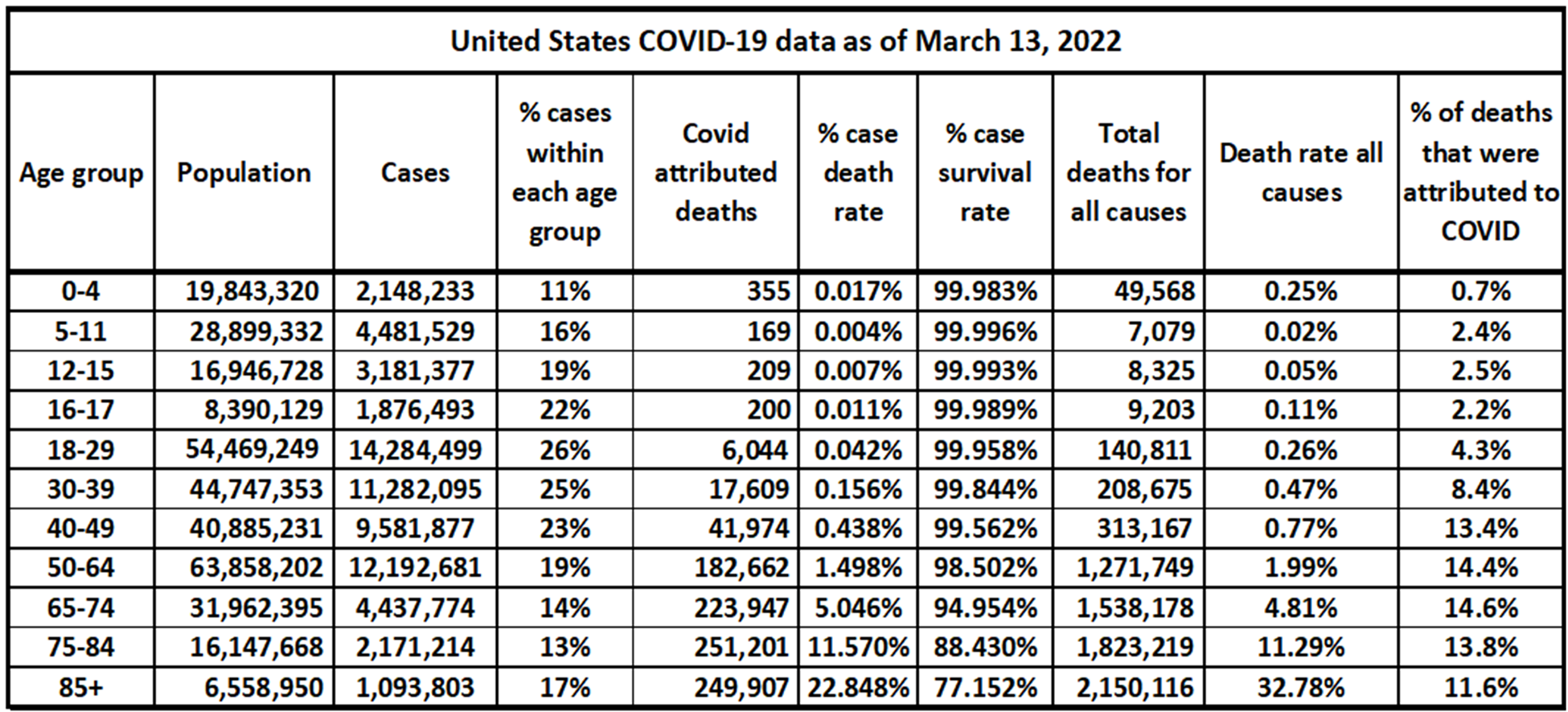Both Pfizer and Moderna have been working for some time on a protocol for their mRNA COVID vaccines for children under the age of 5 years. The expectation is that Moderna will submit data to the U.S. Food and Drug Administration (FDA) some time in the next few weeks.[1]There are numerous challenges associated with producing an effective vaccine for children under 5 against COVID, including:[2][3][4]
a) The vaccines are designed for the original COVID strain rather than newer strains such as Omicron. This is an issue for all demographics.
b) The immune systems of very young children may respond to vaccines differently, and there is concern over the durability, or longevity, of the immune response.
c) Ensuring the vaccines are safe.
When Moderna – and likely Pfizer, at a later date – submit their data to the FDA, we will report on it using methods similar to those outlined in this article Analysis of the Pfizer COVID vaccine trial for children aged 5 to 11 on the Pfizer vaccine for children age 5 to 11. We will also delve into some of the particular challenges regarding the longevity of the immune response to the vaccine and vaccine protocols for younger children.
The key questions we ask in this article are:
- How sick do young children get from COVID infection, and is that changing?
- Is there sound reasoning behind the decision to vaccinate young children?
We vaccinate for benefit
Most parents’ first concern is to the direct benefit of their children. Protecting the interests of their children is, after all, the primary role of the parent. Very young children must rely on their parents to contend with complex medical questions regarding the youngsters’ well being. As explained in this article Prisoner’s dilemma and vaccination, the decision to vaccinate may be framed as a rational problem involving an assessment of the risks and benefits. This analysis can be broken down as a series of questions:
a) How likely is my child to contract COVID?
b) What are the harms of the disease for my child and their probabilities?
c) What are the potential harms of the vaccine and their probabilities?
Because the COVID vaccines are not 100% effective, as demonstrated in this article Are booster shots actually boosting? and this article, The best missed prediction: disease severity 50% lower than we predicted we must add:
d) How effective is the vaccine at preventing the harms from the disease?
This last question serves to moderate the ratio between the second and third questions, that is, the ratio of the harm from the disease versus the vaccine.
Let us start by addressing the severity of COVID for children.
Harms from COVID: cases and death rates for children
We compiled data from the Centers for Disease Control and Prevention (CDC) and the U.S. Census Bureau to catalogue the age-categorized number of reported cases of COVID and related deaths in the United States from the beginning of the COVID pandemic to March 13, 2022. That data is displayed in the table below.[5][6][7][8]Deaths from all causes were also recorded for the same period of time. The COVID-related estimates cannot reflect unreported cases or cases that do not include the age of the infected individual. As of March 13, 2022, there were 66,731,575 COVID reported cases and 974,277 COVID-related deaths in the U.S. for which demographic data was known.[9][10][11]
The key points from this data:
- More than 2 million children under age 5 have contracted COVID in the U.S. to date.
- Fewer COVID deaths occur in children under age 5 than in adults (355 vs. 973,344 in the U.S. to date, respectively).
- The case fatality rate is higher for children under age 5 relative to older children, though it remains significantly lower than all adult case fatality rates.

Estimated population in the U.S. by age group, reported cases for each age group, and number of deaths by COVID and by all causes. The percentage of cases within each age group is relative to the population within that age group.[12][13][14][15][16]
Most COVID-related deaths and most total deaths occur in the older ages, however there are more subtle effects at the very young end of the demographic spectrum. We chart—below—the case death rate and the all-causes death rate by age, excluding individuals over 50 years old, so that we can minimize the visual effect of the oldest age categories. This chart shows the slight rise in both estimates of death rate for children aged 0 to 4.
It is important to note that the COVID case death rates are the death rates as a proportion of cases in the demographic category, while the all-cause death rates are the deaths as a proportion of the number of all the individuals in the demographic category. The fact that the denominators are different for these two rates is critical in their comparison, however their trend shape is the key lesson to be gleaned.
This data reinforces that it is the very old and the very young in our society that are most vulnerable to deaths of all causes. COVID reflects this, although not perfectly.

The U.S. COVID-19 case death rate and death rate for all causes as of March 13, 2022, across the history of COVID, and for ages below 50 years. Both death rates trend higher with age, though the 0-4 age range reverses this trend to a small degree. Note that case death rates are case based, while the all causes death rate is based on the entire population.[17][18][19][20][21]
Hospitalization and evidence that Omicron might be affecting younger children more
The death rate data was cumulative over the entire history of COVID. The CDC has collected weekly data of COVID-associated hospitalizations. This may include hospitalizations “with COVID” as well as “for COVID” as discussed in this article Exploring potential biases in estimating vaccine effectiveness. A chart of this data is shown below for the period of October 31, 2020, to March 19, 2022, and is given as per 100,000 population. We show three age demographics – under 5, 5-17, and over 18. The over-18 rates are always highest. Through most of the time period, under 5 and 5-17 track similarly, with the under-5 group usually (but not always) being a little higher. During the Omicron surge, this changed; the under-5 group showed a substantial increase relative to the older children’s group.
Similar results were noted during the Omicron surge in Ontario, Canada.[22]
These results suggest that Omicron may have a greater relative effect on the very young children compared to previous strains.

COVID-associated weekly hospitalization demographics for the United States from October 31, 2020, to March 19, 2022, showing the rate per 100,000 of three age groups: under 5, 5-17, and over 18. Through most of this period of time, the two children’s age group numbers have tracked with similar rates, but during the Omicron surge in December and January, the rate for children under 5 increased substantially.[23]
Interpretation
Our data is backward looking – much of the death data refers to that observed in the past rather than the present. The age-specific case and death rates may suggest that COVID has not, cumulatively, been a serious disease in children compared to adult age groups. However, higher hospitalizations for young children with Omicron is worth contextualizing before introducing health policies related to the youngest age groups. Of course, we cannot predict the behaviour of future variants. That said, we can sum up our observations of the benefits for children as follows:
- Children under the age of 5 years old catch COVID in high numbers, so the chances of a child catching COVID are not insignificant.
- Compared to all other causes of death, very few children die of COVID, though both are higher for children under age 5 than in children age 5-17.
- The rate of hospitalizations for children under the age of 5 increased during the Omicron surge. This may be relevant to both question of whether to vaccinate and changes in the disease itself.
We do not yet have the data for the adverse effects of vaccinating children aged 0 to 4, but we will delve into this alongside the issues of vaccine effectiveness and the longevity of immunity in future articles.
References
[1] Neergaard, Lauran, March 23, 2022, Moderna Says Its Low-Dose COVID Shots Work for Kids Under 6, NBC
[2] Neergaard, Lauran, March 23, 2022, Moderna Says Its Low-Dose COVID Shots Work for Kids Under 6, NBC
[3] Christensen, Jen, March 25, 2022, Where the US stands on COVID-19 vaccines for children under 5, CNN
[4] Shirley, Debbie-Ann, March 31, 2022, Pediatrician explains how COVID-19 vaccines for the youngest children are being tested, Medical Xpress
[5] CDC, March 23. 2022, Provisional COVID-19 Deaths: Focus on Ages 0-18
[6] CDC, March 23, 2022, Provisional COVID-19 Death Counts by Age in Years, 2020-2021
[7] Statista, March 13, 2022, Total number of cases of COVID-19 in the United States as of November 18, 2021, by age group
[8] U.S. Census Bureau, March 23, 2022, Population Clock
[9] CDC, March 23. 2022, Provisional COVID-19 Deaths: Focus on Ages 0-18
[10] CDC, March 23, 2022, Provisional COVID-19 Death Counts by Age in Years, 2020-2021
[11] Statista, March 13, 2022, Total number of cases of COVID-19 in the United States as of November 18, 2021, by age group
[12] CDC, March 23. 2022, Provisional COVID-19 Deaths: Focus on Ages 0-18
[13] CDC, March 23, 2022, Provisional COVID-19 Death Counts by Age in Years, 2020-2021
[14] Statista, March 13, 2022, Total number of cases of COVID-19 in the United States as of November 18, 2021, by age group
[15] U.S. Census Bureau, March 23, 2022, Population Clock
[16] CDC, March 23, 2022, COVID Data Tracker
[17] CDC, March 23. 2022, Provisional COVID-19 Deaths: Focus on Ages 0-18
[18] CDC, March 23, 2022, Provisional COVID-19 Death Counts by Age in Years, 2020-2021
[19] Statista, March 13, 2022, Total number of cases of COVID-19 in the United States as of November 18, 2021, by age group
[20] U.S. Census Bureau, March 23, 2022, Population Clock
[21] CDC, March 23, 2022, COVID Data Tracker
[22] Government of Ontario, March 23, 2022, Weekly Epidemiological Summary COVID-19 Cases with Severe Outcomes: December 12, 2021 to March 26, 2021
[23] CDC, March 26, 2022, Rates of COVID-19-Associated Hospitalization
(Lee Hunt – BIG Media Ltd., 2022)


